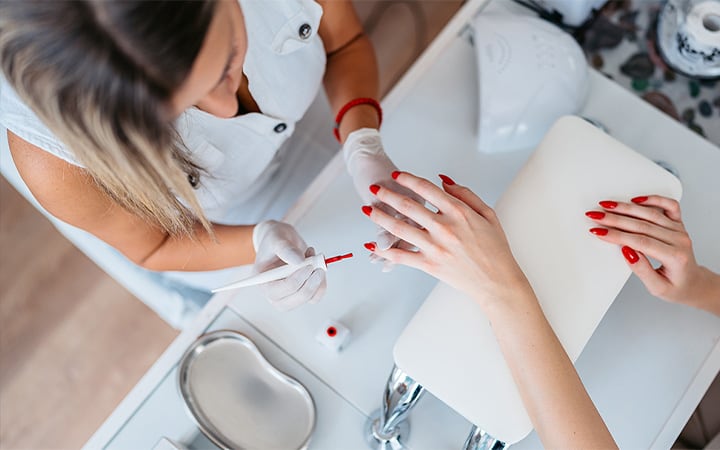Is Your Gel Manicure Safe? What the EU’s Ban Means for You
September 15, 2025

For many women, getting a manicure is a form of self-care, but the European Commission (EU) recently banned a common ingredient in gel polishes, trimethylbenzoyl diphenylphosphine oxide (TPO), citing potential health concerns. The move has left many wondering: Could getting a gel manicure be hazardous to your health?
“TPO in various nail products is still considered safe and acceptable in the U.S. for multiple reasons,” says Rosanne Paul, DO, a University Hospitals dermatologist and Assistant Professor of Dermatology at the Case Western Reserve School of Medicine.
What’s TPO and Why Was It Banned?
A gel manicure is a nail treatment in which a gel-based polish is applied to the nails and a UV or LED light device is used to cure (set and harden) each coat. This process creates a glossy, chip-resistant finish that typically remains flawless for a few weeks.
Gel manicures have raised concerns about the increased risk of skin cancer on hands from the UV light used to cure the polish. Now, TPO is raising new concerns.
The EU has banned TPO in nail polish based on preliminary findings of animal studies that suggest TPO may cause infertility, fetal abnormalities, and problems with the liver and kidneys. This doesn’t necessarily mean that TPO in nail polish would have the same effects on humans. “The ban was precautionary, as these studies involved higher doses than what may be used in a simple gel manicure,” says Dr. Paul.
It seems unlikely such a ban would be instituted stateside anytime soon, since the U.S. tends to require clear evidence that an ingredient or product causes a health risk to humans before the FDA takes it off the market. TPO complies with FDA regulations and is currently considered safe.
Should You Stop Getting Gel Manicures?
When weighing the risks of gel nail polish, it’s important to remember that the levels of TPO administered to the animals in the studies were significantly higher than what you’d encounter getting your nails done at a salon.
Additionally, with studies being limited, it’s unclear how much of the chemical might be able to penetrate through the nail bed into the human body, and how great the risk to fertility, reproductive health or organs might be.
“The nail plate acts as a barrier, so exposure is low,” says Dr. Paul. “The chemical properties of TPO, specifically its high molecular weight and its low water solubility, also make it difficult for it to penetrate through the fingernails and be absorbed by the body’s systems.” More research is necessary, but so far no dangerous effects have been observed in large-scale studies of humans.
The health risks raised by the EU’s ban are not the only ones that have been linked to gel polishes. “It’s more common for TPO to cause local skin reactions, like irritation or allergic contact dermatitis,” says Dr. Paul. Health experts have expressed concerns about increased risk of skin cancer from the UV light used by devices to cure gel polishes. They’ve also flagged skin allergies, premature aging of the hands and other skin problems.
“People who work with TPO regularly (like nail technicians) may be at higher risk of systemic absorption and other potential adverse effects, since they’re breathing it in over prolonged periods of time,” says Dr. Paul.
Gel polish doesn’t always contain TPO, so if you want to be cautious and avoid it, look for TPO-free nail polishes. If the ingredients just say “photoinitiator,” do a little research to find out which one it is, since there are other photoinitiators besides TPO.
Tips for Better Nail Health
Taking care of your nails is important. Your nails protect against bacteria and infection, and they reflect your overall health. The American Academy of Dermatology (AAD) warns that gel polish can be “tough” on nails, especially if you use it repeatedly. To keep your nails healthy, the AAD and other skin health experts recommend that you:
- Apply broad-spectrum, water-resistant SPF 30 (or higher) sunscreen to your hands to protect against UV radiation, especially before setting them in a UV gel polish device.
- To remove gel polish, use acetone and apply it directly to your nail. Don’t soak your whole hand in it – or pick at gel polish to remove it.
- Consider using regular nail polish instead of gel polish (regular nail polish doesn’t contain TPO or require exposure to UV light to set it).
- Moisturize your nails and cuticles several times a day.
- Take breaks from wearing nail polish, especially gel polishes if you’re experiencing nail problems.
Finally, if you notice any problems or unusual changes with your nails, alert your doctor or dermatologist.
Related Links
University Hospitals has a vast network of primary care providers and dermatologists with the training and experience to diagnose and treat a wide variety of diseases and disorders including conditions that affect the fingernails and toenails.


